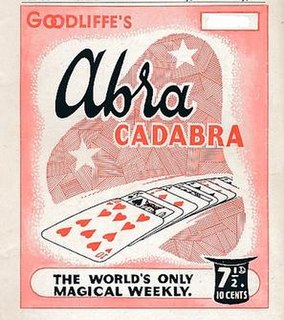This page is based on this
Wikipedia article Text is available under the
CC BY-SA 4.0 license; additional terms may apply.
Images, videos and audio are available under their respective licenses.
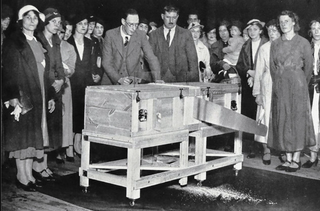
Sawing a woman in half is a generic name for a number of stage magic tricks in which a person is apparently sawn or divided into two or more pieces.
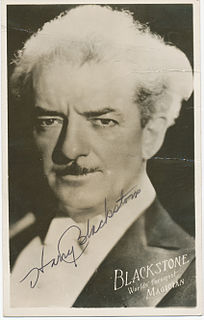
Harry Bouton Blackstone was a famed stage magician and illusionist of the 20th century. Blackstone was born Harry Bouton in Chicago, Illinois, he began his career as a magician in his teens and was popular through World War II as a USO entertainer. He was often billed as The Great Blackstone. His son Harry Blackstone Jr. also became a famous magician. Blackstone Sr. was aided by his younger brother, Pete Bouton, who was the stage manager in all his shows. Blackstone Sr. was married three times. Blackstone Jr. was his son by his second wife.
The Mismade Girl is a stage illusion, designed by American magician Chuck Jones. It is a variation of the sawing a woman in half illusion.
The Zig-Zag Girl illusion is a stage illusion akin to the more famous sawing a woman in half illusion. In the Zig-Zag illusion, a magician divides an assistant into thirds, only to have them emerge from the illusion at the end of the performance completely unharmed.

Jim Steinmeyer is an American author, inventor, and designer of magical illusions and theatrical special effects. He holds four U.S patents in the field of illusion apparatus, including a modern version of the Pepper's Ghost illusion. Steinmeyer has consulted for many famous magicians, including David Copperfield, Doug Henning, Siegfried and Roy, and Lance Burton.
Alan Shaxon was a professional magician and a former president of The Magic Circle. He specialised in cabaret performances and was billed as one of England's foremost magicians.

Kristen Johnson is an award-winning escape artist who works with her husband magician Kevin Ridgeway under the names Living Illusions, Ridgeway & Johnson and Breathless. She was the featured magician on the cover of the June 2009 issue of the magicians' magazine The Linking Ring.

The Assistant's Revenge is a transposition illusion in which two performers change places. It was created by magician and inventor Robert Harbin.
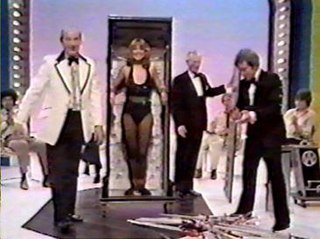
The Radium Girl is a stage illusion of the classic type involving a female assistant in a large box and is probably best categorised as a penetration or restoration-type illusion. Its origins and history are much less well documented than those of many other "big box" illusions but some sources indicate it might be one of the earliest examples of that type of trick. References and picture captions indicate it was the creation of British magician and designer Val Walker.

The Devil's Torture Chamber is a magic stage illusion of the classic type involving a female magician's assistant in a large box and is probably best categorised as a penetration or restoration-type illusion.
The World's Most Dangerous Magic was the title of two American television specials showcasing illusion and escapology acts, which were made for the NBC network. The first was originally broadcast on 27 April 1998 and the second, titled The World's Most Dangerous Magic 2, was initially aired on 2 May 1999.
Impaled is a classic stage illusion in which a performer appears to be impaled on or by a sword or pole. The name is most commonly associated with an illusion that was created by designer Ken Whitaker in the 1970s and which is sometimes also referred to as "Beyond Belief" or "Impaled Beyond Belief".
This version has become part of the stage magic repertoire and has been performed by many of the world's most famous magic acts.
Stage illusions are large-scale magic tricks. As the name implies, stage illusions are distinct from all other types of magic in that they are performed a considerable distance away from the audience, usually on a stage, in order to maintain the illusion. Examples of stage illusions include sawing a woman in half and Lady-to-Tiger.

The Tarbell Course in Magic is a notable encyclopedia of magic amongst professional and amateur magicians. It has eight volumes; the first five were part of the original home-study correspondence course compiled in 1928 by Dr. Harlan Tarbell, the remaining three volumes being added on later.
Clearly Impossible is a variation of the illusion of sawing a woman in half devised by Jonathan Pendragon.

Magic, along with its subgenres of, and sometimes referred to as illusion, stage magic or close up magic is a performing art in which audiences are entertained by staged tricks or illusions of seemingly impossible feats using natural means. It is to be distinguished from paranormal magic which are effects claimed to be created through supernatural means. It is one of the oldest performing arts in the world.
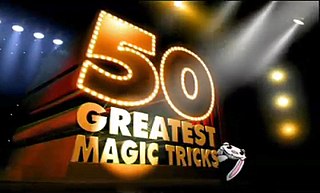
50 Greatest Magic Tricks is a one-off list show that was produced by Objective Productions for Channel 4. The programme counted down the fifty greatest magic tricks, as voted for by members of The Magic Circle. The illusion at number one was Death Saw by David Copperfield. The show was presented by British comedy duo Adam and Joe, who also wrote and narrated the programme. The show was first broadcast on Channel 4 on 6 May 2002.



